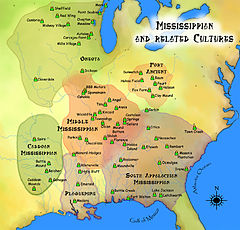- Mobilian Jargon
-
Mobilian Spoken in Gulf coast and Mississippi Valley Extinct active through 1960s Language family pidgin, Muskogean basedLanguage codes ISO 639-3 mod Mobilian Jargon (also Mobilian trade language, Mobilian Trade Jargon, Chickasaw–Choctaw trade language, Yamá) was a pidgin used as a lingua franca among Native American groups living along the Gulf of Mexico around the time of European settlement of the region. The name refers to the Mobile Indians of the central Gulf Coast.
Mobilian Jargon facilitated trade between tribes speaking different languages. European exploring parties, such as that of Hernando de Soto, often had Mobilian-speaking guides along as interpreters.
Contents
Distribution
Mobilian was used from the Florida northwest coast and area of the current Alabama-Georgia border westward as far as eastern Texas and in the north from the lower Mississippi Valley (currently south and central Illinois) to the southern Mississippi River Delta region in the south. It is known to have been used by the Alabama, Apalachee, Biloxi, Chacato, Pakana, Pascagoula, Taensa, and Tunica.
Origins
Mobilian is a pidginized form of Choctaw and Chickasaw (both Western Muskogean) that also contains elements of Eastern Muskogean languages such as Alabama and Koasati, colonial languages including Spanish, French, and English, and perhaps Algonquian and/or other languages. Pamela Munro has argued that Choctaw is the major contributing language (not both Choctaw and Chickasaw) although this has been challenged by Emanuel Drechsel.
Grammar
It has a simplified syllable and sound structure and a simplified grammar as compared to Choctaw, its primary parent language.
Bibliography
- Munro, Pamela (1984). "On the Western Muskogean source for Mobilian". International Journal of American Linguisics 50 (4): 438–450. doi:10.1086/465852.
- Drechsel, Emanuel (1987). "On determining the role of Chickasaw in the history and origin of Mobilian Jargon". International Journal of American Linguisics 53: 21–29. doi:10.1086/466040.
- Drechsel, Emanuel. (1997). Mobilian Jargon: Linguistic and Sociohistorical Aspects of a Native American Pidgin. Oxford University Press
External links
 Pre-Columbian North America
Pre-Columbian North AmericaArchaeological cultures North American pre-Columbian chronology – Adena – Alachua – Ancient Pueblo (Anasazi) – Baytown – Belle Glade – Buttermilk Creek Complex – Caborn-Welborn – Calf Creek – Caloosahatchee – Clovis – Coles Creek – Deptford – Folsom – Fort Ancient – Fort Walton – Fremont – Glades – Glacial Kame – Hopewell (List of Hopewell sites) – Hohokam – Leon-Jefferson – Mississippian (List of Mississippian sites) – Mogollon – Monongahela – Old Cordilleran – Oneota – Paleo-Arctic – Paleo-Indians – Patayan – Plano – Plaquemine – Poverty Point – Prehistoric Southwest – Red Ocher – Santa Rosa-Swift Creek – St. Johns – Steed-Kisker – Tchefuncte – Tocobaga – Troyville
Archaeological sites Angel Mounds – Bandelier National Monument – The Bluff Point Stoneworks – Cahokia – Chaco Canyon – Casa Grande – Coso Rock Art District – Eaker – Effigy Mounds National Monument – Etowah Indian Mounds – Eva – Folsom Site – Fort Ancient – Fort Center – Gila Cliff Dwellings National Monument – Holly Bluff Site – Hopewell Culture National Historical Park – Kincaid Mounds – Kolomoki – Manitou Cliff Dwellings – Marksville – Meadowcroft Rockshelter – Mesa Verde – Moorehead Circle – Moundville – Mummy Cave – Nodena Site – Ocmulgee National Monument – Old Stone Fort – Parkin Park – Pinson Mounds – Portsmouth Earthworks – Poverty Point – Pueblo Bonito – Rock Eagle – Rock Hawk – Salmon Ruins – Serpent Mound – Spiro Mounds – SunWatch – Taos Pueblo – Toltec Mounds – Town Creek Indian Mound – WintervilleMiscellaneous Ballgame – Black drink – Buhl woman – Calumet – Chunkey – Clovis point – Container Revolution – Eastern Agricultural Complex – Eden point – Effigy mound – Falcon dancer – Folsom point – Green Corn Ceremony – Horned Serpent – Kennewick man – Kiva – Metallurgy – Mi'kmaq hieroglyphic writing – Medicine wheel – Mound builders – N.A.G.P.R.A. – Norse colonization of the Americas – Piasa – Pueblo dwellings – Southeastern Ceremonial Complex – Three Sisters agriculture – Thunderbird – Underwater panther
Categories:- Pidgins and creoles
- Languages of the United States
- Indigenous languages of the North American Southeast
- Extinct languages of North America
- Mississippian culture
Wikimedia Foundation. 2010.


